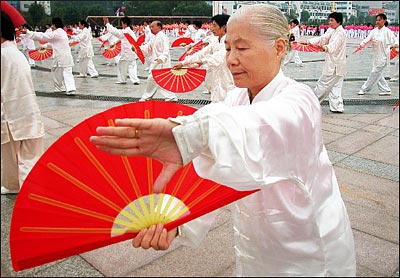| Tools: Save | Print | E-mail | Most Read |
| Nationwide Physical Fitness Program |
| Adjust font size: |
The Physical Health Law of the People's Republic of China was adopted in 1995. In the same year, the State Council promulgated the Outline of Nationwide Physical Fitness Program, followed by a series of rules and regulations. A survey released by the State Physical Culture Administration indicates that at present nearly 40 percent of the total population aged between 7 and 70 take exercise and more than 60 percent of urban residents go to sports clubs for physical fitness activities. By the end of 2005, 37 percent of China's total population had taken part in regular physical exercise, and over 95 percent of students reached the National Physical Exercise Standard.
Aiming to improve the health and the physical condition of the general population, the Nationwide Physical Fitness Program, with an emphasis on young people and children, encourages everyone to engage in at least one sport activity every day, learn at least two ways of keeping fit and have a health examination every year. The government has stipulated that 60 percent of the proceeds from the sports lottery must go to the Nationwide Physical Fitness Program. Making use of the lottery proceeds, the State Physical Culture Administration had constructed about 6,000 nationwide physical fitness projects throughout rural areas by the end of 2005. Starting from 2001, the Administration earmarked lottery money as pilot funds to build "China Sports Lottery Nationwide Physical Fitness Centers" as pilot projects in 31 large and medium-sized cities throughout China, amongst them Dalian, Beijing and Changchun. Some are already in use. Meanwhile, some 196 million yuan of sports lottery proceeds were used to construct public sporting facilities in China's less-developed western areas and the Three Gorges region of the Yangtze River, benefiting 101 counties and towns. With the flourishing of nationwide fitness activities, people's attitudes have also undergone great change. In many large and medium-sized cities, spending money in the pursuit of good health has become trendy. Some of the newly emerging sports, including rock climbing, horsemanship, bungee jumping, bowling, skateboarding, women's boxing, shuffle board, taekwondo and golf are particularly popular among the young. At the end of 2003, construction work was started on China's first snow golf course in A'er Mountain, Inner Mongolia. This project, representing an investment of about 1 billion yuan, will be the sixth snow golf course in the world. The Nationwide Physical Fitness Program has set targets that, by 2010, more than 40 percent of China's population will participate in regular physical exercise, there will be a clear improvement in the national physique and a major increase in the number of fitness sites so as to satisfy people's keep-fit needs. |
| Tools: Save | Print | E-mail | Most Read |
 |
| Related Stories |
